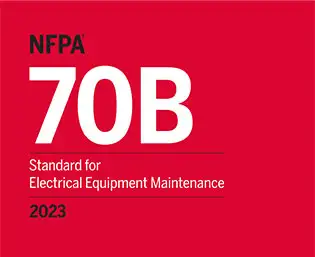Analog Multimeters

NFPA 70b Training - Electrical Maintenance
Our customized live online or in‑person group training can be delivered to your staff at your location.

- Live Online
- 12 hours Instructor-led
- Group Training Available
Download Our OSHA 3075 Fact Sheet – Understanding Electrical Hazards in the Workplace

- Learn the effects of electric current on the human body
- Understand OSHA safety standards and protective devices
- Discover essential lockout/tagout and grounding practices
An analog multimeter is a manual electrical measuring tool that uses a needle display to test voltage, current, and resistance. It’s ideal for detecting gradual changes in readings and is commonly used for troubleshooting, continuity checks, and battery testing.
What is an Analog Multimeter?
An analog multimeter is a traditional electrical test instrument that displays readings with a needle on a dial.
✅ Measures voltage, current, and resistance accurately
✅ Useful for observing slow or fluctuating signals
✅ Preferred for simple field diagnostics and continuity checks
Analog multimeters use a needle to indicate a reading along a scale. Switched-range analog multimeters are very affordable but can be difficult for beginners to read accurately, especially on resistance scales. Each type of meter has its advantages. An analog multimeter is often used to measure voltage levels in circuits where rapid fluctuations are visible on the needle display.
Power Quality Analysis Training
Request a Free Power Quality Training Quotation
Used as a voltmeter, a digital meter is usually preferable because its resistance is significantly higher, typically 1 M or 10 M, compared to 200 Ω for an analog multimeter on a similar range. On the other hand, it is easier to follow a slowly changing voltage by watching the needle on an analog display. Used as an ammeter, analog multimeters have a very low resistance and are very sensitive. More expensive digital multimeters can equal or better this performance. Most modern multimeters are digital, and traditional analog multimeters are becoming obsolete. When troubleshooting voltage drop in long circuits, analog meters can help identify subtle shifts more effectively than digital ones.
The basic functionality of an analog multimeter includes measuring electrical potential in volts, resistance in ohms, and current in amps. Analog multimeters can be used to find electronic and electrical short circuit problems. Advanced analog multimeters come with additional features, such as capacitor, diode, and IC testing modes. Specific measurements made by analog multimeters include DC voltage, AC voltage, DC current, AC current, frequency range for AC currents, and decibel measurement. Analog multimeters that measure current may have a current clamp built in or configured as a probe. A current clamp is a sensor that clamps around the wire. When searching for analog multimeters, it is crucial to consider the measurement range that corresponds to the specific value being measured. An analog multimeter displays these values via a dial, typically a moving pointer or needle. Analog multimeters are generally bench-top or handheld. Benchtop models can also be portable, equipped with handles and wheels. Hand-held multimeters are specifically designed to be used while holding, i.e, can be operated with one hand. Understanding watts law is essential for interpreting analog multimeter readings related to power and current flow.
Analog multimeters have multiple scales on the dial, a moving needle and many manual settings on the function switch. It’s tricky to spot the correct scale to read on the dial, and you sometimes have to multiply the reading by 10 or 100 to get your final value. Depending on the features (which should include continuity testing capabilities), prices start at approximately $15.
For appliance and electronic repairs, it may be better to purchase a digital multimeter rather than an analog one. This type is much simpler to read, and you can change the functions on it more easily. Digital multimeters have LCD readouts, do continuity testing, and cost from $35 on up. Some digital multimeters also feature auto-ranging, overload protection, and other advantages that analog multimeters lack. For easier, hands-free viewing, choose an analog multimeter with a stand that allows it to be propped up or hung on a wall. If an analog multimeter doesn’t come equipped with either jumper wires or alligator clips (both of which cost around $4 each), purchase them. Alligator clips are often used to firmly grip wiring or contacts for hands-free, safe, and accurate readings. Both types of multimeters and these accessories can be purchased at electronics stores, home centers and hardware stores. While a voltmeter measures voltage directly, an analog multimeter offers additional capabilities, such as resistance and current testing, in one device. For current measurement, it's important to know what ammeters measure to properly configure an analog multimeter’s settings.
Sign Up for Electricity Forum’s Test Equipment Newsletter
Stay informed with our FREE Test Equipment Newsletter — get the latest news, breakthrough technologies, and expert insights, delivered straight to your inbox.
Common features of analog multimeters include battery power, overload protection, temperature compensation, a mirrored scale, a range switch, a diode test, and a battery test. Devices with battery power can be operated without a plug-in power. Multimeters with overload protection feature a fuse or other protection mechanism to safeguard the meter. Temperature-compensated devices have programming or electrical devices designed to counteract known errors caused by temperature changes. A mirrored scale makes it easier to read the instrument to a given accuracy by enabling the operator to avoid parallax errors. A range switch is used to select the appropriate range of units to be measured. A device with a diode test has methods for testing diode operation. A device with a battery test has methods for testing battery operation. An important environmental parameter to consider when searching for analog multimeters is the operating temperature. To understand how analog multimeters compare with modern tools, see our overview of what is a multimeter and the differences between analog and digital models.
Related Articles




